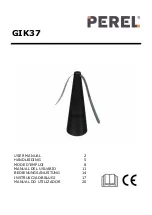
Using Lucina
217
Defibrillation and Cardioversion
Lucina is designed to safely absorb the energy discharged from manual and automatic defibrillators.
Standard defibrillation energy levels should be used for positive learning reinforcement and to avoid
negative training transfer.
However, use of a defibrillator for training purposes represents an operational hazard equivalent to use
of a defibrillator on a real patient. Consequently, ALL SAFETY PRECAUTIONS for the use of defibrillators
MUST BE FOLLOWED as if the simulator were a patient. Consult the specific defibrillator’s User Manual
for further information.
The following cautions should be observed:
• Defibrillation should be performed on the defibrillation electrodes only. If
defibrillation is performed over any ECG electrode, high voltage may be
present on the remaining connectors during the shock. This may also
damage ECG circuitry. Avoid touching any nearby ECG posts.
• To prevent overheating, DO NOT provide more than three (3) defibrillation
discharges in a sequence per minute during the training session (maximum
200 joules with biphasic defibrillation and 360 joules with a monophasic
defibrillation). Avoid a large number of consecutive discharges as may
damage the simulator. Leave at least 30 minutes recovery period after a
sequence of more than nine consecutive discharges.
• Do NOT provide more than nine consecutive discharges over three minutes
without recovering for 30 minute before the next discharge as it may
damage the simulator.
• Do NOT let the simulator come in contact with electrically conductive
surfaces or objects during defibrillation. A flame-supporting atmosphere,
for example, with a high content of oxygen, should be avoided during
defibrillation.
• Keep the simulator’s chest dry. Special attention should be taken when
using the urinary system or the vaginal bleeding features.
• To prevent pitting of the chest skin electrode, do NOT apply conductive gel
or conductive defibrillation pads intended for patient use.
• Do NOT use cables or connectors having visible damage.
• Do NOT spill fluids over any component inside the simulator torso. This
could damage the system and may also present a possible hazard for the
operator.
• When using a manual defibrillator, the ECG can be monitored via the
defibrillator paddles. Coarse ventricular fibrillation and high-rate
ventricular tachycardia cardiac rhythms are automatically recognized as
“shockable” rhythms.
• With each defibrillation, the simulator automatically records the amount of
energy discharged and the time defibrillation was performed. The
Summary of Contents for Fidelis Lucina
Page 1: ...User Guide Maternal Fetal Simulator...
Page 2: ...2015 CAE Healthcare 905K470052 v2 1...
Page 28: ...Table Of Contents xxvi This page intentionally blank...
Page 36: ...Equipment Overview 8 This page intentionally blank...
Page 190: ...Using M se 162 This page intentionally blank...
Page 226: ...Using the TouchPro CTG Monitor 198 This page intentionally blank...
Page 266: ...Using Lucina 238 This page intentionally blank...
Page 298: ...Care and Maintenance 270 This page intentionally blank...
Page 389: ......















































